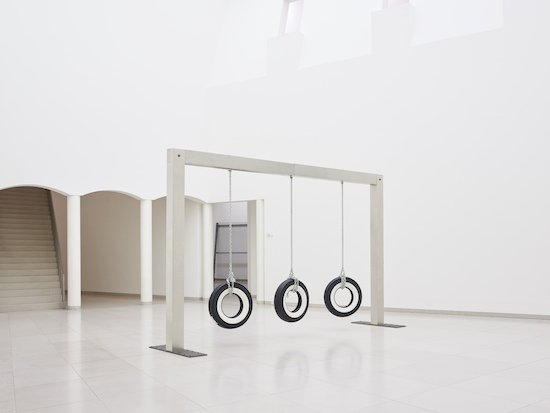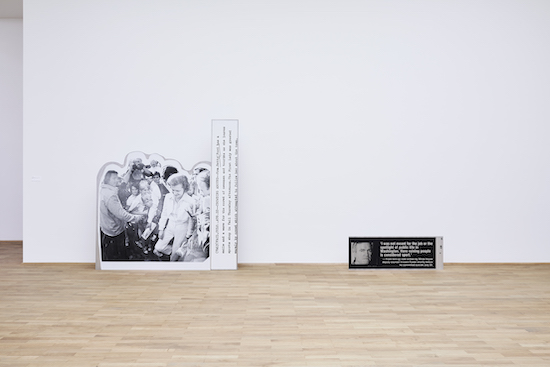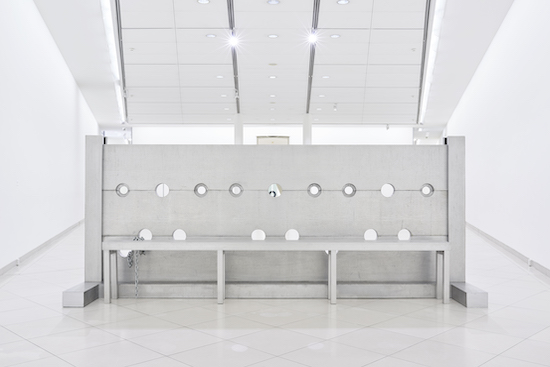Cady Noland, Tower of Terror (back), 1993/1994, Glenstone Museum, Potomac, Maryland (US)
Installation view MUSEUM MMK FÜR MODERNE KUNST, Photo: Fabian Frienzel
I like America and America likes me. So ran the title of a 1974 action piece by Joseph Beuys where, swathed in felt, the one-time Stuka flyer shared a room with a coyote for three days. Perhaps the German art star really was a big fan of the good ol’ USA; it made a change from shooting folks as a rear-gunner in a Ju-87 dive-bomber. But these days not everyone is enamoured of the Land of the Free. In our Trump times even those born and bred there are having their doubts. Cady Noland has long been one such.
This show comes as a surprise because Noland has maintained a significant distance from the contemporary art world for some time. Many of the sculptures here date back to the late 1980s and early 1990s. Her reclusive stance might share a Pynchon-esque scepticism about fame and unwanted media attention. Publicity came though when one of her works Oozewald (1989), a silkscreen ink on aluminium image of Lee Harvey Oswald caught in the immediate aftermath of his shooting by Jack Ruby, sold for $6.6 million in 2011. Here it has a space to itself, bullet holes are cut out of the metal and Lee gags on the flag, a real Old Glory. Aside from the rarity of this outing the importance of Noland’s reappearance is made more acute by the fact that there are over eighty works to mull on the three floors of labyrinthine space at the MMK.
Starting with Publyk Sculpture (1994), three whitewall tires are suspended by metal link chains from a frame that looks like a set of goalposts or a gallows. You might be reminded of the rubber necklace killings in South Africa but that would be a bit wide of the mark. There is a near literary thread to the display of Noland’s oeuvre here; the nooks and crannies of the gallery reveal the subplots and thematic developments and the relevance of these tires will become apparent by the end of the show.
Here too are fencing, barriers and walls: Noland’s imagery of exclusion has a startling contemporary relevance. There are works here that prefigure Trump’s obsession with the Mexican border as with Institutional Field (1991) and Industrial Park (1991) with their chunks of chain-link fencing. In another work pipes and stanchions form a square like a boxing ring with each corner topped by a stack of Zimmer frames. The owners of the walkers have long gone gently into that not so good night. This is Frame Device (1989) and it might be the ultimate metaphor for, in Philip Roth’s words, the massacre that is old age.
More instruments of restraint and control are found in Tower of Terror (1993), a set of stocks made in aluminium over metal complete with chain and padlocks. The holes where victims put their heads through recall those bullet wounds in Oozewald. Staying with crime and punishment, Bloody Mess (1988) is a spill of beer cans with a rear-view mirror, a police cap, handcuffs, and a metal pipe. We think of Rodney King then and Black Lives Matter now.

Cady Noland, Publyck Sculpture, 1994, Glenstone Museum, Potomac, Maryland
Installation view MUSEUM MMK FÜR MODERNE KUNST, Photo: Fabian Frienzel
There are more works about political violence – Noland’s historical parade of American killings recalls Stephen Sondheim’s ‘Assassins’ (1990). We see Booth – The Big Plunge (1989) that references Lincoln’s killer. And upstairs… isn’t that Squeaky Fromme? Didn’t she try and kill Gerald Ford? Surrounded!!! (1993/1994) is another silkscreen, this time on steel, that shows two of the Manson girls.
Noland’s scathing take on male psychopathy in the States is foregrounded. America’s inordinate obsession with contact sport is referenced in Model With Entropy (1984) – the earliest work here – with its mitt, a scuffed football helmet and a deflated basketball. Noland’s pithy sculpture stares in horror at her country’s queasy fascination with the American jock and beats on the brat with a baseball bat.
Car culture takes a whipping too. Untitled (1989) is a metal shopping basket with a some spent Budweiser beer tins, chains, and car polish, and Cart Full of Action (1986) has rims, an exhaust, and yet more red, white and blue coloured product – a can of STP oil treatment. You can’t imagine Noland being a big Top Gear fan.

on the left: Cady Noland, Walk and Stalk, 1993/1994, San Francisco Museum of Modern Art
(US); Gift of Vicki and Kent Logan; on the rigtht: Cady Noland, IMPACT ON THE IMAGE, 1993/1994, The Broad Art Foundation Installation view MUSEUM MMK FÜR MODERNE KUNST, Photo: Fabian Frienzel
Deep Social Space (1989) is perhaps the most scabrous work with its pillorying of various masculine hobbies. Yet another American flag is defiled – Noland shrinks the supposed symbolic value of the Star-Spangled Banner with greater critical intent than Jasper Johns – there’s more Budweiser, a pile of crisps, a barbecue set, horse saddles, bread rolls, another set of handcuffs. The detritus of a deranged stag party implicit with threat.
Several guest works act paternally to Noland’s obsessions: Touch (1963) is by her own father Kenneth, the great colour field painter; Warhol’s White Disaster II (1963) highlights her debt to his interest in celebrity and death; Beuys’ Boxkampf für direkte Demokratie (1972) is a vitrine with boxing gloves and gum shield that warns us if you tell the truth to power you’d better protect yourself or you’re gonna to get hurt.
What about the recurring presence of those whitewall tires? These recall her father’s fascination with targets but there’s even more dark Western history at work here. Trashing Folgers (1993/1994) is yet another silkscreen ink on aluminium plate that shows us the playground at Barker Ranch, a notorious hideout of the Manson Family – and here is one of those tires used incongruously as a child’s swing. Here the gang played after slaying the coffee heiress Abigail Folger.
An insistent message thumps as incessantly as a pile driver: America is sick. Noland exposes her country’s psychopathology with a laconic repositioning of its symbolic objects. She has a seer’s vision – that rarest of gifts bestowed on an artist. As potent as the Weimar works of George Grosz she warns and points ahead to the oppressive conditions of our future by giving us a fearful blast of Un-American broadcasting.
Cady Noland is at MMK, Frankfurt, until 31 March


